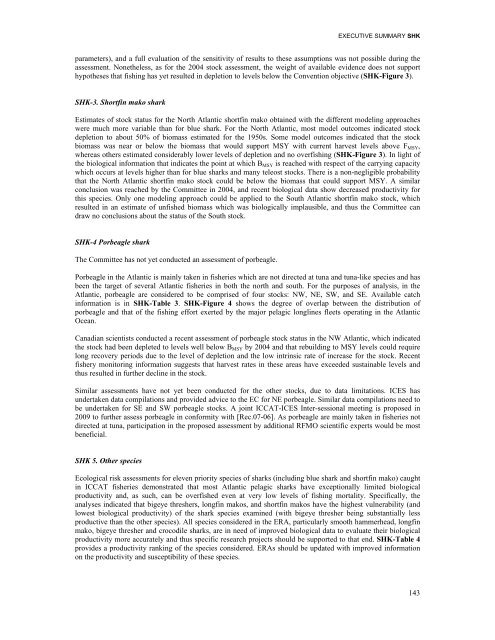REPORT OF THE STANDING COMMITTEE ON RESEARCH ... - Iccat
REPORT OF THE STANDING COMMITTEE ON RESEARCH ... - Iccat
REPORT OF THE STANDING COMMITTEE ON RESEARCH ... - Iccat
Create successful ePaper yourself
Turn your PDF publications into a flip-book with our unique Google optimized e-Paper software.
EXECUTIVE SUMMARY SHKparameters), and a full evaluation of the sensitivity of results to these assumptions was not possible during theassessment. Nonetheless, as for the 2004 stock assessment, the weight of available evidence does not supporthypotheses that fishing has yet resulted in depletion to levels below the Convention objective (SHK-Figure 3).SHK-3. Shortfin mako sharkEstimates of stock status for the North Atlantic shortfin mako obtained with the different modeling approacheswere much more variable than for blue shark. For the North Atlantic, most model outcomes indicated stockdepletion to about 50% of biomass estimated for the 1950s. Some model outcomes indicated that the stockbiomass was near or below the biomass that would support MSY with current harvest levels above F MSY ,whereas others estimated considerably lower levels of depletion and no overfishing (SHK-Figure 3). In light ofthe biological information that indicates the point at which B MSY is reached with respect of the carrying capacitywhich occurs at levels higher than for blue sharks and many teleost stocks. There is a non-negligible probabilitythat the North Atlantic shortfin mako stock could be below the biomass that could support MSY. A similarconclusion was reached by the Committee in 2004, and recent biological data show decreased productivity forthis species. Only one modeling approach could be applied to the South Atlantic shortfin mako stock, whichresulted in an estimate of unfished biomass which was biologically implausible, and thus the Committee candraw no conclusions about the status of the South stock.SHK-4 Porbeagle sharkThe Committee has not yet conducted an assessment of porbeagle.Porbeagle in the Atlantic is mainly taken in fisheries which are not directed at tuna and tuna-like species and hasbeen the target of several Atlantic fisheries in both the north and south. For the purposes of analysis, in theAtlantic, porbeagle are considered to be comprised of four stocks: NW, NE, SW, and SE. Available catchinformation is in SHK-Table 3. SHK-Figure 4 shows the degree of overlap between the distribution ofporbeagle and that of the fishing effort exerted by the major pelagic longlines fleets operating in the AtlanticOcean.Canadian scientists conducted a recent assessment of porbeagle stock status in the NW Atlantic, which indicatedthe stock had been depleted to levels well below B MSY by 2004 and that rebuilding to MSY levels could requirelong recovery periods due to the level of depletion and the low intrinsic rate of increase for the stock. Recentfishery monitoring information suggests that harvest rates in these areas have exceeded sustainable levels andthus resulted in further decline in the stock.Similar assessments have not yet been conducted for the other stocks, due to data limitations. ICES hasundertaken data compilations and provided advice to the EC for NE porbeagle. Similar data compilations need tobe undertaken for SE and SW porbeagle stocks. A joint ICCAT-ICES Inter-sessional meeting is proposed in2009 to further assess porbeagle in conformity with [Rec.07-06]. As porbeagle are mainly taken in fisheries notdirected at tuna, participation in the proposed assessment by additional RFMO scientific experts would be mostbeneficial.SHK 5. Other speciesEcological risk assessments for eleven priority species of sharks (including blue shark and shortfin mako) caughtin ICCAT fisheries demonstrated that most Atlantic pelagic sharks have exceptionally limited biologicalproductivity and, as such, can be overfished even at very low levels of fishing mortality. Specifically, theanalyses indicated that bigeye threshers, longfin makos, and shortfin makos have the highest vulnerability (andlowest biological productivity) of the shark species examined (with bigeye thresher being substantially lessproductive than the other species). All species considered in the ERA, particularly smooth hammerhead, longfinmako, bigeye thresher and crocodile sharks, are in need of improved biological data to evaluate their biologicalproductivity more accurately and thus specific research projects should be supported to that end. SHK-Table 4provides a productivity ranking of the species considered. ERAs should be updated with improved informationon the productivity and susceptibility of these species.143
















